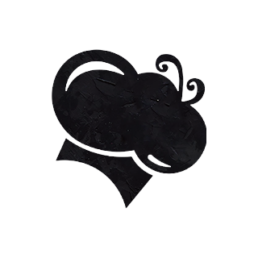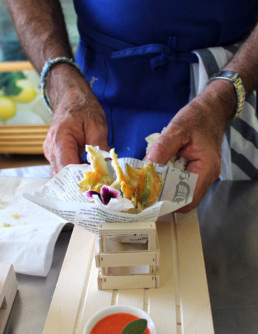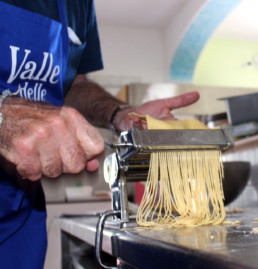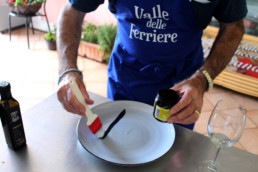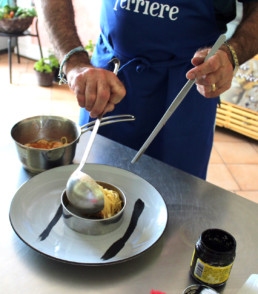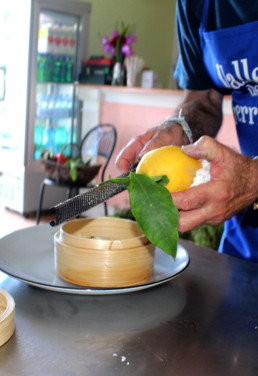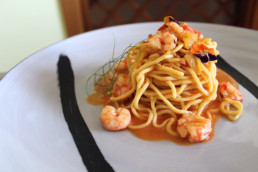My Amalfi Cooking School Experience
Ben B. Philips
During our summer 2018 trip to Europe, my family went on a side trip to the Amalfi Coast of Italy for a few days. We stayed at the beautiful beachfront Hotel Santa Caterina. While there, I decided to try a lesson at a cooking school. The concierge at the Santa Caterina found me a rare one-on-one lesson with a young chef, Diego Criscuolo, who, in his off hours, runs Valle delle Ferriere cooking class in Amalfi. While Mr. Criscuolo is a full-time assistant chef at a famous hotel in Ravello, he has set aside so many hours a week to run his cooking class, in a fully equipped spot, perched high above Amalfi – in the quaint town of Pontone, just below the village of Scala – a stone’s throw across the valley from Ravello.
On the morning of my class, to my surprise, I was picked up at my hotel by Diego himself, and enjoyed a beautiful and scenic (guided) tour up into the mountains above Amalfi. After arriving at his school, I was provided an apron, hat, and a written set of preparation instructions (for my later reference) for all of the items on the menu that day. Diego explained the how’s and why’s and what’s of our plan to cook each course. I was literally overwhelmed by the quantity and quality of the inventory of kitchen equipment, flours, foodstuffs, vegetables, fruits, oils, cheeses, meats, fish, etc., that were perfectly arranged and discretely set aside as the ingredients and instruments ready for the preparation of each dish. I had never before appreciated the logistical planning that goes into even something as simple as making the sauce to go over a steamed fish.
For instance, we fileted the fish and peeled shrimp at 11:00 a.m. (put the raw seafood in the refrigerator) and started cooking the shrimp shells with garlic, water, and oil in one pot, and started cooking the fish head and carcass/backbone with carrots, onions, celery, tomatoes, olive oil, etc. in another pot. Both of these “broths” (“shrimp broth” and “fish broth”) would not be used until later, but had to be cooked ahead. In the meantime, we prepared a ball of pasta, cheese stuffing for zucchini flowers, and tomato sauces. I do not recall using any canned ingredients. Everything was fresh and made from scratch. I was simply amazed at the amount of planning, number of ingredients, skill, special equipment, knowledge, and time (lots of time), that is involved in this tradition called “Italian” cuisine. In the future, if I can just duplicate one of Diego’s creations, I will be happy.
On that memorable day, Diego and I prepared, then together we ate, the following:
- Tagliolini pasta with shrimps and pasta (the sauce was made with a portion of the reduction of the “shrimp broth” prepared an hour or so before)
- Steamed Red Snapper with Fish Broth (prepared further with moka pot) with seasonal vegetables
- Zucchini flowers filled with lemon flavored ricotta cheese and baby prawns, tempura fried and dressed with tomato and ginger coulis
- Lemon sorbet (made at the start of the lesson and frozen for two hours)
Each dish, when finished, was placed on our table for two (2) on the patio outside his building, under an umbrella, overlooking the waters of Amalfi and on eye-level with the beautiful Hotel Villa Maria across the short spanse of valley in Ravello. A simply gorgeous vista from which to eat, and I forgot to say, continue sipping all of the wonderful wines Diego provided with each dish (and during the cooking process!)
When finished, I was looking for a hammock to take a nap. It was not to be. Instead of taking me straight back to my hotel, Diego drove higher up the mountain to the village of Scala, to his favorite spot in Amalfi (which will remain secret unless you take his class) with the most beautiful view on the coast. We sat in the shade, had a gin and tonic (with Amalfi lemon and ice!), and watched the boats (which looked like little water bugs from that distance) come and go to Amalfi.
As I sat there with this kind and talented young man, and listened as he chatted away about the history of the area, this special spot of his (he grew up on this mountain and his family still lives there), his visions of becoming a famous chef, and his realistic assessment of that daunting challenge, I had an epiphany. I realized someone at least needed to, in some way, memorialize this magical day – even if just briefly. So here it is – without the hundreds of details/steps that were taken by us in the cooking class that day – which one can only experience first-hand.
In conclusion, I highly recommend this experience, especially to novice cooks like me. The several wonderful Italian meals and wines you will consume are worth the entire experience (and price). Learning to cook the food is a bonus!
